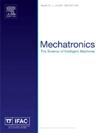上肢双侧末端执行器机构运动学优化设计及康复性能评价
IF 3.1
3区 计算机科学
Q2 AUTOMATION & CONTROL SYSTEMS
引用次数: 0
摘要
脑卒中所致肢体残疾严重影响日常生活活动,而上肢康复训练对促进运动功能的恢复起着至关重要的作用。目前,上肢康复机器人的研究存在体积大、成本高、缺乏综合康复性能评价等问题。本研究在前人提出的上肢末端执行器双侧康复机器人系统(EBReRS)的基础上,推导其正逆运动学,计算雅可比矩阵,绘制奇异分析和性能图集,优化连杆尺寸,提高其操作性能,使其能够更有效地执行康复任务。根据表面肌电图(sEMG)信号,获得肌肉的激活水平。利用评估数据,建立肌肉与训练模式之间的映射关系,引入定制化肌肉训练。实验结果表明,在训练过程中正确的模式映射可以将肌肉激活水平提高1到5倍。在未来,EBReRS有望应用于更广泛的家庭康复,并且所提出的康复评估策略具有应用于其他康复机器人的潜力。本文章由计算机程序翻译,如有差异,请以英文原文为准。

Kinematic optimal design and rehabilitation performance evaluation of an upper-limb bilateral end-effector mechanism
Limb disabilities caused by stroke can severely impact activities of daily living (ADLs), and upper limb rehabilitation training plays a crucial role in promoting the recovery of motor functions. Currently, the studies of upper limb rehabilitation robots have several drawbacks, such as bulkiness, high costs, and the lack of integrated rehabilitation performance evaluation. This study, building on the previously proposed upper limb end-effector bilateral rehabilitation robotic system (EBReRS), derives its forward and inverse kinematics, calculates the Jacobian matrix, plots singularity analysis and performance atlases, and optimizes link dimensions to enhance operational performance, enabling it to carry out rehabilitation tasks more effectively. Based on surface electromyography (sEMG) signals, muscle activation levels were obtained. Utilizing the evaluation data, customized muscle training was introduced by establishing a mapping between muscles and training modes. Experimental results indicate that correct mode mapping during training can enhance muscle activation levels by a factor of 1 to 5. In the future, EBReRS is expected to be utilized for more widespread home rehabilitation, and the proposed rehabilitation evaluation strategy has the potential to be applied to other rehabilitation robots.
求助全文
通过发布文献求助,成功后即可免费获取论文全文。
去求助
来源期刊

Mechatronics
工程技术-工程:电子与电气
CiteScore
5.90
自引率
9.10%
发文量
0
审稿时长
109 days
期刊介绍:
Mechatronics is the synergistic combination of precision mechanical engineering, electronic control and systems thinking in the design of products and manufacturing processes. It relates to the design of systems, devices and products aimed at achieving an optimal balance between basic mechanical structure and its overall control. The purpose of this journal is to provide rapid publication of topical papers featuring practical developments in mechatronics. It will cover a wide range of application areas including consumer product design, instrumentation, manufacturing methods, computer integration and process and device control, and will attract a readership from across the industrial and academic research spectrum. Particular importance will be attached to aspects of innovation in mechatronics design philosophy which illustrate the benefits obtainable by an a priori integration of functionality with embedded microprocessor control. A major item will be the design of machines, devices and systems possessing a degree of computer based intelligence. The journal seeks to publish research progress in this field with an emphasis on the applied rather than the theoretical. It will also serve the dual role of bringing greater recognition to this important area of engineering.
 求助内容:
求助内容: 应助结果提醒方式:
应助结果提醒方式:


